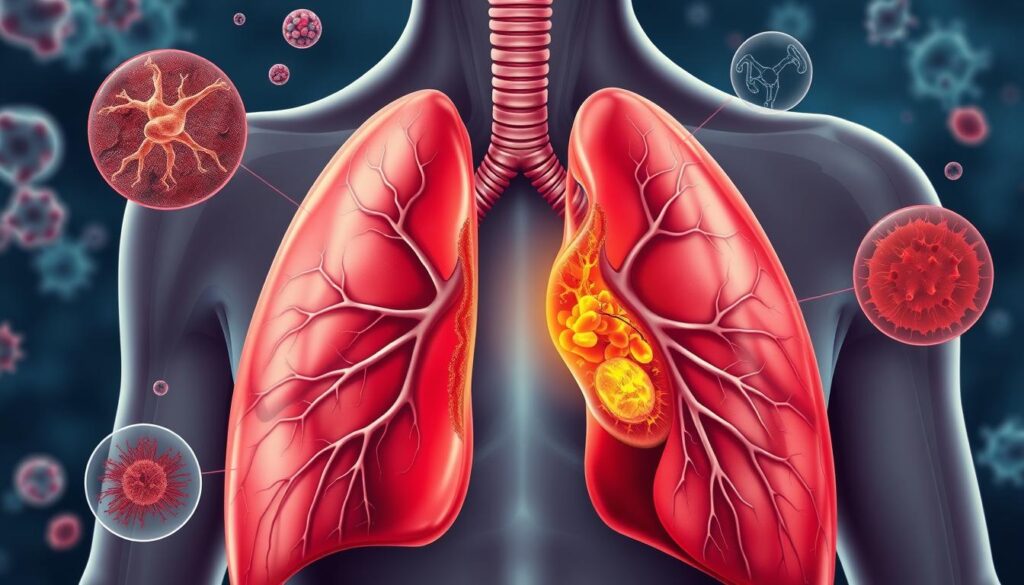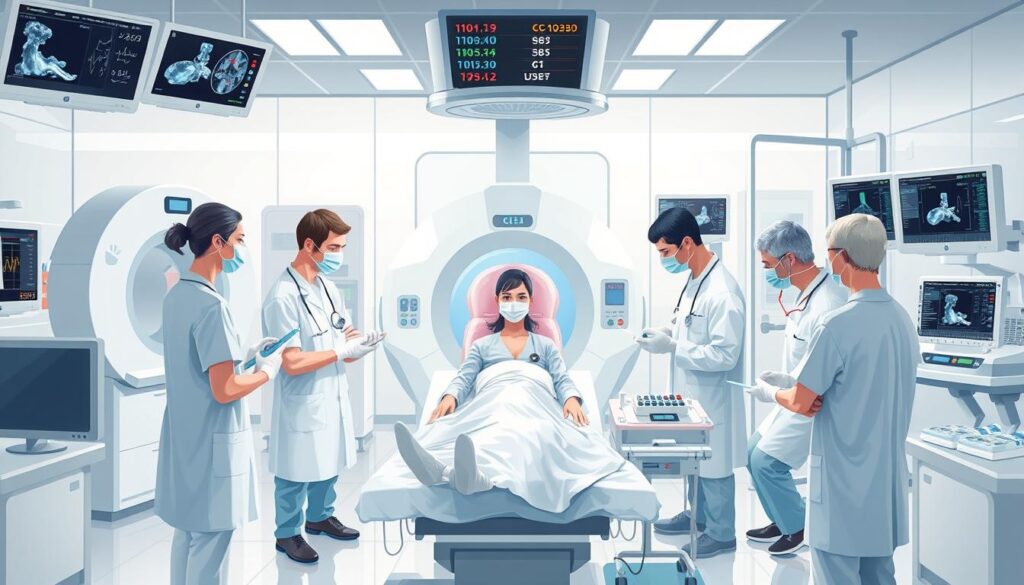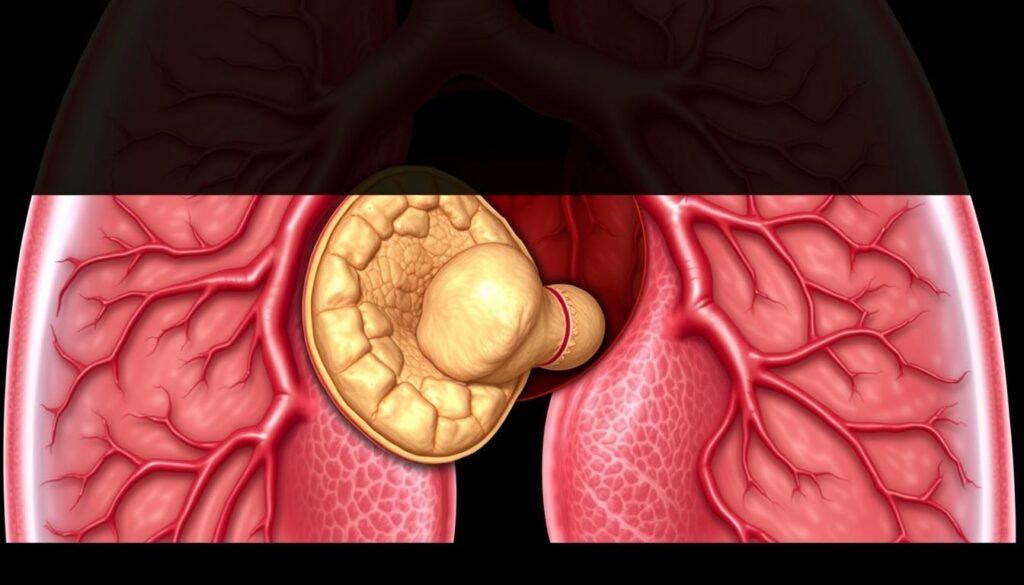This shows how important it is to know about lung abscesses. We will look into what causes them, their symptoms, and how to treat them.

Key Takeaways
- Lung abscess is a severe form of pulmonary infection characterized by the formation of a pus-filled cavity in the lung tissue.
- Anaerobic bacteria, particularly Streptococcus and Staphylococcus species, are the primary culprits in the development of lung abscesses.
- Underlying health conditions, such as diabetes, alcoholism, and immunodeficiency, can increase the risk of developing a lung abscess.
- Early detection and prompt treatment, often involving a combination of antibiotic therapy and surgical intervention, are crucial for successful management of lung abscesses.
- Preventive measures, including good oral hygiene and lifestyle modifications, can help reduce the risk of developing a lung abscess.
What is a Lung Abscess: Definition and Overview
A lung abscess is a pocket of pus in the lung tissue. It usually happens because of a severe lung infection. This condition, also known as pulmonary suppuration, can cause a lung cavity filled with harmful material. Knowing how lung abscesses form and their types is key to understanding their importance.
Formation Process of Pulmonary Suppuration
Lung abscesses form when bacteria, like anaerobic species, enter the lung and cause inflammation. This leads to a pus-filled cavity in the lung. The infection might start from swallowing something harmful, spreading from another part of the body, or from a lung infection that gets worse.
Types of Lung Abscesses
- Primary lung abscesses: These happen because of a lung infection, often from swallowing harmful substances.
- Secondary lung abscesses: These are complications from other infections in the body.
- Necrotizing pneumonia: A severe lung infection that can turn into an abscess, causing tissue death and a lung cavity.
Clinical Significance
Lung abscesses can cause serious problems like breathing issues and sepsis if not treated. Quick diagnosis and treatment are vital to stop the infection from spreading. Healthcare professionals need to understand lung abscesses to manage this serious lung condition effectively.
Common Causes and Risk Factors of Lung Abscess
Lung abscesses are a serious lung infection. They can happen for many reasons. One big reason is aspiration pneumonia. This happens when people accidentally breathe in food, liquids, or stomach acid into their lungs. This can cause a pus-filled cavity in the lung tissue.
Another reason is bronchiectasis. This is a long-term lung condition that makes airways wide and scarred. It makes it easy for harmful bacteria to grow, including anaerobic ones, leading to abscesses.
- Aspiration pneumonia
- Bronchiectasis
- Anaerobic bacteria infections
There are also things that make some people more likely to get a lung abscess. These include:
- A weak immune system, like in HIV/AIDS or after cancer treatment
- Drinking too much alcohol
- Having diabetes
- Poor dental health or dental problems
- Neurological issues that make it hard to swallow, like stroke or Parkinson’s disease
Knowing what causes lung abscesses helps doctors prevent and treat them better.
“Prompt recognition and management of lung abscesses are essential to prevent serious complications and improve patient outcomes.”
| Cause | Description |
|---|---|
| Aspiration pneumonia | Inhalation of food, liquids, or stomach contents into the lungs, leading to infection and abscess formation. |
| Bronchiectasis | Chronic lung condition characterized by abnormal widening and scarring of the airways, creating an environment conducive to bacterial growth and abscess development. |
| Anaerobic bacteria | Certain types of bacteria that thrive in the absence of oxygen, contributing to the formation of lung abscesses. |
Signs and Symptoms of Pulmonary Infection
It’s important to know the early signs of a lung infection like a lung abscess or necrotizing pneumonia. These conditions can get worse fast. So, it’s key to watch for symptom changes.
Early Warning Signs
The first signs of a lung infection might be:
- A persistent cough that brings up foul-smelling, discolored sputum
- Fever and chills
- Chest pain or discomfort when you breathe deeply
- Fatigue and feeling generally unwell
Advanced Symptoms
As the infection gets worse, you might notice:
- Shortness of breath or trouble breathing
- Breathing quickly and shallowly
- Excessive sweating, especially at night
- Significant weight loss and loss of appetite
Emergency Warning Signs
Some lung infections can get very bad, very fast. You need to get help right away if you have:
- Severe, persistent chest pain
- Coughing up blood or thick, foul-smelling sputum
- Sudden, severe shortness of breath or trouble breathing
- Confusion, disorientation, or feeling off mentally
Quick action is key to treating a lung infection or necrotizing pneumonia. If you see any of these symptoms, get medical help fast.
Diagnostic Methods and Testing
Healthcare professionals use many tools to find lung abscesses. They aim to spot a lung cavity or localized pneumonia. These signs show if someone has this lung problem. Let’s look at the main ways doctors check for lung abscesses.
Imaging Studies
Chest X-rays are key in spotting lung abscesses. They can show a lung cavity or dense areas, hinting at an abscess. But, computed tomography (CT) scans are needed for a clear view of the abscess’s size and details.
Laboratory Tests
Doctors also run lab tests to help diagnose lung abscesses. These tests include:
- Blood tests to check for infection signs, like high white blood cell counts or C-reactive protein levels.
- Sputum culture and analysis to find the bacteria causing the infection.
- Bronchoscopy, a way to get samples from the airways for more tests.
Together, imaging and lab results help doctors confirm a lung abscess diagnosis. Then, they can plan the right treatment.
“Accurate and timely diagnosis is crucial for the effective management of lung abscesses, as it allows for the implementation of targeted treatment strategies.”
With these diagnostic tools, doctors get a full picture of the patient’s health. This leads to better treatments and outcomes for patients.
Understanding the Role of Anaerobic Bacteria
Lung abscesses are a type of lung infection caused by anaerobic bacteria. These bacteria grow well in places with little oxygen. Knowing how they work helps doctors treat the infection better.
Common Bacterial Strains
The main anaerobic bacteria found in lung abscesses are Bacteroides, Peptostreptococcus, and Fusobacterium. These bacteria form tough colonies. They are hard to kill with usual antibiotics.
Infection Mechanisms
- Anaerobic bacteria grow well in the low-oxygen abscess environment. They create a necrotic, purulent cavity.
- These bacteria make toxins and enzymes that harm host tissue. This makes the lung infection worse.
- Their ability to form biofilms makes them hard to fight. Biofilms protect them from the immune system and antibiotics.
Bacterial Resistance Patterns
Many anaerobic bacteria have become resistant to antibiotics like clindamycin and metronidazole. This makes treatment harder. Doctors might need to use stronger antibiotics or surgery in serious cases.
“Understanding the role of anaerobic bacteria in lung abscesses is crucial for devising effective treatment strategies and preventing complications.”
Treatment Approaches and Medical Interventions
Treating a lung abscess involves several steps. The main goal is to get rid of the infection, avoid serious problems, and help the body heal. Different treatments are used, based on how bad the infection is, the bacteria causing it, and the patient’s health.
Antibiotics are a key part of treating lung abscesses. Doctors give broad-spectrum antibiotics through an IV to fight common bacteria. The treatment lasts from 4 to 6 weeks, depending on how well the patient responds.
Sometimes, draining the abscess is needed. This can be done through a procedure guided by images or surgery. These methods help the abscess heal faster and prevent more problems.
| Treatment Option | Effectiveness | Potential Risks |
|---|---|---|
| Antibiotic Therapy | High success rate when targeted to the specific bacterial strain | Antibiotic resistance, side effects, prolonged treatment duration |
| Percutaneous Drainage | Effective in draining the abscess, can accelerate healing | Procedural risks, such as bleeding or infection at the drainage site |
| Surgical Drainage | Highly effective in severe or complex cases, can remove the entire abscess | Surgical risks, such as bleeding, infection, and complications from general anesthesia |
In some cases, a mix of antibiotics and drainage is needed. The healthcare team will decide the best treatment plan for each patient. This ensures the best chance for recovery.

Managing a lung abscess well is key to avoiding serious issues and improving chances of recovery. By knowing the treatment options and following the doctor’s advice, patients can get back on the road to health.
Complications and Prevention Strategies
Lung abscesses can be treated, but they can also lead to serious problems if not handled right. It’s important to know the risks and take steps to prevent them. This helps keep your lungs healthy.
Potential Complications
One big risk is necrotizing pneumonia, where the infection spreads to other parts of the body. This can cause sepsis, a dangerous condition where the body’s immune system gets out of control. Another risk is aspiration pneumonia, when the abscess contents get sucked into the lungs, causing more infection and swelling.
Preventive Measures
- Treat any conditions that might lead to lung abscesses, like diabetes or a weak immune system.
- Keep your mouth clean and take care of your teeth to stop bacteria from reaching your lungs.
- Stay away from things that can cause you to swallow air, like too much alcohol or trouble swallowing.
- Get vaccinated against pneumococcal and flu infections, which can raise your risk of lung abscesses.
Lifestyle Modifications
Changing your lifestyle can also help prevent lung abscesses and stop them from coming back:
- Stop smoking and avoid secondhand smoke to keep your lungs working well and fight off infections better.
- Eat a healthy diet full of fruits, veggies, and lean proteins to boost your immune system.
- Exercise regularly to keep your lungs healthy and strengthen your body against germs.
- Wash your hands well to stop bacteria from spreading and getting into your lungs.
Knowing the risks of lung abscesses and taking steps to prevent them can help protect your lungs. This way, you can stay healthy and avoid serious lung infections.
| Potential Complications | Preventive Measures |
|---|---|
| Necrotizing pneumonia | Prompt treatment of underlying conditions |
| Aspiration pneumonia | Proper oral hygiene and dental care |
| Sepsis | Avoidance of aspiration-inducing activities |
| Vaccination against pneumococcal and influenza infections |
Recovery and Long-term Prognosis
Recovering from a lung abscess takes time, but most people can get better with the right treatment. It’s all about managing the cause, dealing with any issues, and getting the lungs working right again.
The size and location of the lung cavity play big roles in recovery. Abscesses in the lung cavity or linked to bronchiectasis need more work. This might mean drainage, antibiotics, or even surgery to heal fully and avoid coming back.
While getting better, you might feel tired, have a cough, or chest pain. It’s crucial to stick to your doctor’s plan and give your lungs time to heal. With patience and following your doctor’s advice, you can get back to your usual self.
The outlook for lung abscess survivors depends on many things. These include the cause, how well treatment works, and your overall health. With the right care and watchful eye, many can lead healthy lives after beating a lung abscess.

“The key to a successful recovery is to closely follow the treatment plan and to be patient, as the healing process can take time.”
To keep your lungs healthy and avoid future problems, consider making some changes. Quit smoking, eat well, and exercise regularly. Also, don’t forget to see your doctor often. This helps ensure a good future for those who’ve had a lung abscess.
Conclusion
Understanding lung abscesses is key to keeping our lungs healthy. These are pockets of pus in the lungs that can be serious if not treated.
It’s important to catch and treat lung abscesses early. This stops the infection from getting worse and prevents serious problems. Knowing what causes them helps us avoid getting sick. Doctors use special tests and treatments to help patients get better.
Managing lung abscesses means knowing how they work and why they happen. It also means using the right medicines to fight the infection. By staying informed, we can help those with lung abscesses get better.
FAQ
Q: What is a lung abscess?
A: A lung abscess is a pocket of pus in the lung. It’s usually caused by bacteria. It’s also called pulmonary suppuration.
Q: How do lung abscesses form?
A: Lung abscesses form when bacteria, often anaerobic, infect the lung. This leads to a localized infection and inflammation. It creates a cavity or abscess in the lung.
Q: What are the different types of lung abscesses?
A: There are primary and secondary lung abscesses. Primary ones are caused by direct infection. Secondary ones are complications of other conditions, like bronchiectasis or necrotizing pneumonia.
Q: Why are lung abscesses clinically significant?
A: Lung abscesses are serious and can cause big problems if not treated. They can harm lung function and even be life-threatening.
Q: What are the common causes of lung abscesses?
A: Common causes include aspiration pneumonia and anaerobic bacterial infections. These can come from poor dental hygiene or conditions like bronchiectasis.
Q: What are the early warning signs of a lung abscess?
A: Early signs include a persistent cough, fever, and chest pain. You might also see foul-smelling, purulent sputum. Later, symptoms like shortness of breath, weight loss, and coughing up blood can appear.
Q: How are lung abscesses diagnosed?
A: Doctors use chest X-rays or CT scans to see the abscess. They also do sputum culture and analysis to find the bacteria.
Q: What role do anaerobic bacteria play in lung abscesses?
A: Anaerobic bacteria like Bacteroides, Fusobacterium, and Peptostreptococcus are common in lung abscesses. They grow well in the low-oxygen lung cavity, causing infection and inflammation.
Q: What are the treatment options for lung abscesses?
A: Treatment includes antibiotics, drainage, and sometimes surgery. The choice depends on the infection’s severity, the bacteria, and the patient’s health.
Q: What are the potential complications of a lung abscess?
A: Complications include infection spreading, respiratory failure, sepsis, and long-term lung damage like bronchiectasis.
